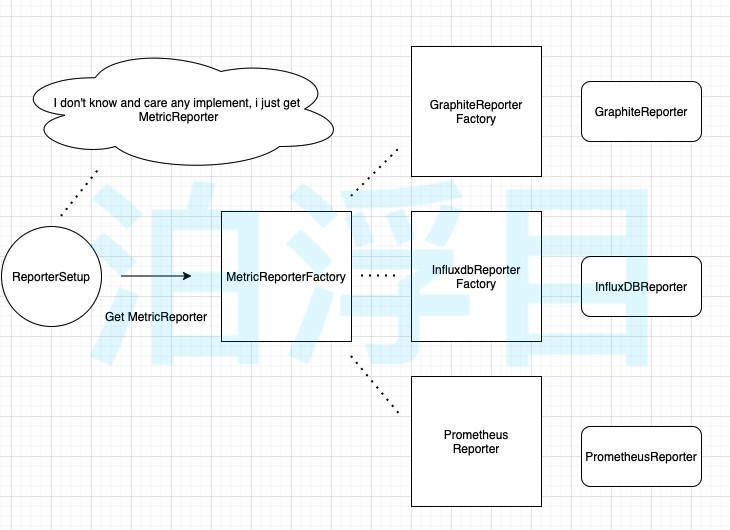| 版本 | 日期 | 备注 |
|---|---|---|
| 1.0 | 2021.10.8 | 文章首发 |
| 1.1 | 2022.3.9 | fix typo |
| 1.2 | 2022.7.3 | fix typo |
0. 前言
前阵子笔者涉及了些许监控相关的开发工作,在开发过程中也碰到过些许问题,便翻读了Flink相关部分的代码,在读代码的过程中发现了一些好的设计,因此也是写成文章整理上来。
本文的源码基于Flink
1.13.2。
1. 扩展插件化
在官网中,Flink社区自己提供了一些已接入的Reporter,如果我们有自己定制的Reporter,也可以根据它的规范去实现自己的Reporter。
在Flink的代码中,提供了反射机制实例化MetricReporter:要求MetricReporter的实现类必须是public的访问修饰符,不能是抽象类,必须有一个无参构造函数。
核心代码为ReporterSetup#getAllReporterFactories:
private static Iterator<MetricReporterFactory> getAllReporterFactories(@Nullable PluginManager pluginManager) {final Iterator<MetricReporterFactory> factoryIteratorSPI =ServiceLoader.load(MetricReporterFactory.class).iterator();final Iterator<MetricReporterFactory> factoryIteratorPlugins =pluginManager != null? pluginManager.load(MetricReporterFactory.class): Collections.emptyIterator();return Iterators.concat(factoryIteratorPlugins, factoryIteratorSPI);}
该代码会通过Java的SPI机制来获取MetricReporter的相关实现类,本质上是通过ClassLoder来获取。
|-- ReporterSetup\-- fromConfiguration //当集群启动时,会从配置读取监控并初始化相关类\-- loadAvailableReporterFactories // 加载有效的Reporter们\-- getAllReporterFactories // 核心代码,通过SPI以及ClassLoader机制获取Reporter们
2. 内置松耦合
上文提到了社区会提供常见的一些监控Reporter。在代码中,本质是工厂模式的实现。
/*** {@link MetricReporter} factory.** <p>Reporters that can be instantiated with a factory automatically qualify for being loaded as a* plugin, so long as the reporter jar is self-contained (excluding Flink dependencies) and contains* a {@code META-INF/services/org.apache.flink.metrics.reporter.MetricReporterFactory} file* containing the qualified class name of the factory.** <p>Reporters that previously relied on reflection for instantiation can use the {@link* InstantiateViaFactory} annotation to redirect reflection-base instantiation attempts to the* factory instead.*/public interface MetricReporterFactory {/*** Creates a new metric reporter.** @param properties configured properties for the reporter* @return created metric reporter*/MetricReporter createMetricReporter(final Properties properties);}
每接入一个监控,只要实现相应的工厂方法即可。目前实现的有:
- org.apache.flink.metrics.graphite.GraphiteReporterFactory
- org.apache.flink.metrics.influxdb.InfluxdbReporterFactory
- org.apache.flink.metrics.prometheus.PrometheusReporter
- org.apache.flink.metrics.prometheus.PrometheusPushGatewayReporter
- org.apache.flink.metrics.statsd.StatsDReporterFactory
- org.apache.flink.metrics.datadog.DatadogHttpReporterFactory
- org.apache.flink.metrics.slf4j.Slf4jReporterFactory
每当社区需要接入新的Reporter时,仅仅需要实现MetricReporterFactory即可,而上层能感知到的也仅仅是MetricReporter,和任何具体实现无关,这也是典型的一种防腐设计。
3. Fail safe
在流计算业务中,如果监控这种旁路逻辑发生问题,是否应该影响到主干逻辑呢?答案是不应该的。
在MetricRegistryImpl中(顾名思义,它会将所有的Reporter注册进这个类),构造函数会将相关的MetricReporter放到线程池中,定期的让它们上报数据。
|-- MetricRegistryImpl\-- constructor
在WebMonitorEndpoint中,也有线程池的身影。这个类提供了RestAPI来便于查询Metric。对于其他组件的请求通过Akka来异步发送,并通过线程池来处理这些回调的回复。
|-- WebMonitorEndpoint\-- start\-- initializeHandlers\-- new JobConfigHandler|-- AbstractExecutionGraphHandler\-- handleRequest
这是典型Fail-safe的设计。
4. 不仅只支持Push
在Flink中,监控数据不仅支持Push,同时还实现了Pull,而实现也非常的简单。
MetricQueryService实现了MetricQueryServiceGateway,这意味着它可以被远程调用。
其监控数据来源代码追踪:
|-- AbstractMetricGroup\-- counter|-- MetricRegistryImpl\-- register|-- MetricQueryService\-- addMetric
上面提到的WebMonitorEndpoint也是一样,不过是基于RestAPI的实现,同样提供了Pull的策略。


